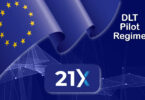Nationwide, among the top 10 insurers in the U.S., was one of the founding members of The Institutes RiskBlock Alliance, the global blockchain consortium with more than thirty insurance members. With the proliferation of alliances across many industries, an important question is how to build an effective and productive consortium.
While the idea of collaborating with competitors may seem daunting, the reality is often less of a challenge.
“I have been really impressed by the ability of the organizations that have participated to be transparent and work together in this consortium model,” said Michael Fulton, Associate VP of Technology Innovation at Nationwide. He also credited RiskBlock’s ability to facilitate the conversation in a productive fashion.
While Nationwide played a leadership role with The Institutes blockchain initiatives even before RiskBlock started, the insurer is comfortable ceding that position to others in the interest of the group. “We’re firm believers that if the only organization that’s associated with RiskBlock from a name standpoint is Nationwide, then RiskBlock’s going to fail over the long term,” said Fulton, adding that all players wanting to be seen as an industry leader should be given the opportunity.
Chubb, Liberty Mutual and several others have stepped up in the early phases to help drive the consortium. But even more insurers need to come forward to demonstrate they are all in this together, he urged.
That opportunity may be just ahead as RiskBlock is structured to have multiple use cases run in parallel. The alliance already has a “software factory” with five of the major consultancies: Accenture, Cap Gemini, Deloitte, EY and IBM.
Laying the groundwork
In these early stages, quite a bit of time was spent focusing on building the foundation. That bedrock is RiskBlock’s Canopy framework, which includes policy and claims blockchains. Additionally, sitting on top of Canopy there were four separate use cases. However, for now, that has been reduced to two to expedite production across multiple carriers.
The current focus is on the “Proof of Insurance” and “First Notice of Loss” applications. Those solutions were selected because they dovetail together in the customer journey. One can envision a mobile app where you don’t just bump phones to exchange insurance details, but in the case of an accident, you could also immediately initiate a claim.
As with anything new, these first two use cases will prove to be the hardest. Rather than doing four projects simultaneously you avoid “everybody trying to get through all of the hard stuff the first time,” Fulton noted. Hence, the remaining two use cases on “subrogation” and “parametric” have been placed on the back burner.
Taking the lead
Each project has a working group, where two members take the lead. In partnership with RiskBlock, they work actively on a weekly basis to develop straw-dog working models. Then every three or four weeks, the rest of the 15-to-20 person group gathers to give feedback on the models.
Initially, with 20 RiskBlock members and four use cases, 40% of members volunteered additional time and effort. RiskBlock now has more than 30 participants and growing, so with a limited number of use cases the percentage may decline.
Measuring success
For “Proof of Insurance”, success will be measured by improved customer satisfaction from automating the exchange of information. For the carriers, the benefits will be efficiency and cost savings.
At a higher level, how will Nationwide measure its ROI on the RiskBlock Alliance investment? “We were able to make the case fairly easily based on amplified learning investment that we were able to get,” said Fulton. “So the initial buy-in for Nationwide was fairly small because we were already Institute members.”
There were additional staffing costs but the company wanted those team members to learn about blockchain anyway. To date, with one small exception, the blockchain team was staffed internally.
There’s likely to be a need for the ROI exercise in the future. “As RiskBlock matures, as the Alliance uses up its initial seed funding, it is going to have to think about what the long-term financial model is for the platform in a non-profit environment.” There will be a need to share the costs somehow.
Considerations involved
The non-profit aspect is one of RiskBlock’s key draws for Nationwide. In for-profit alliances, the long-term financial benefit can accrue to early shareholders, which is less inclusive.
Size matters for blockchain consortia. So the fact that the RiskBlock Alliance is part of The Institutes with 1700 plus carrier connections is another advantage.
Nationwide considered other alternatives such as R3 and B3i. The insurer is also keeping a watchful eye on other Distributed Ledger Technologies (DLT) like Hashgraph. But its vision was more aligned with RiskBlock than anything else. That included RiskBlock’s use of Ethereum in the early days. However, Nationwide agrees with RiskBlock’s technology evolution and the “enterprise capability that Corda brings to the table,” Fulton said.
R3’s Corda DLT was initially designed for banks but has proved popular with insurers. As it’s not a blockchain, only the parties to a transaction store the data on their servers, optimizing privacy protections.
“I don’t think that over the long term this is going to be as hard as we think it is when it comes to using blockchain and Distributed Ledger Technologies. I think that if RiskBlock continues to go down the path it’s going down, and then continues to do this the way that it’s envisioning and planning, I think that the work on the carrier side will tend to be fairly minimal and fairly API driven,” Fulton explained.
One thing to watch, he warns, is that “the Consortium has been a little more heavily weighted to IT and technology leader participation than it has been business participation.” There is the potential to gain value and depth from including people with richer business knowledge, Fulton emphasized.
Was the Software Factory a risk?
RiskBlock with its software factory decided to “go slow to go fast”. By building the foundations for the future, it perhaps slowed things initially, but there’s an upside. Fulton explained: “We now have an engine that is capable of delivering and scaling with the platform and scaling very quickly with the platform as we go from getting these first two use cases into production to trying to tackle another 5, 10, 20 more use cases.”
But the Nationwide executive says the idea of building a substantial platform first was not a slam dunk. Some might argue it was over-engineering at the early stage. “I would say that the jury is still out whether it was the right choice because I think to some extent as an industry the jury is still out on blockchain. The jury’s still out on whether companies come together and really collaborate utilizing this technology?”
“I am not a 100% convinced that blockchain is the way of the future,” he said provocatively. “But the technology of distributed ledger, I think it’s going to be here in the insurance industry, and it’s going to be in a whole lot of other industries, for the long term.”
If you’re interested in learning more about Blockchain and Insurance, Hanson Wade is running a conference in Philadelphia in November. For a 10% ticket discount quote code 9702LDGIN10. We’ve found Hanson Wade events have strong speakers, hardly any sponsor promotional content, and provide excellent networking opportunities.







